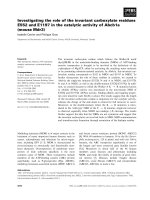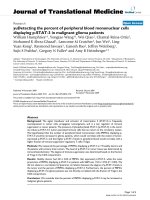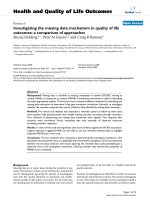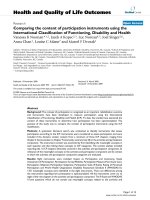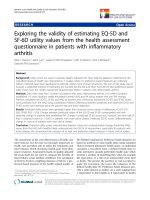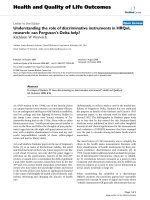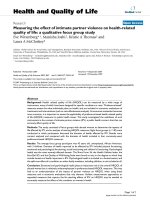Báo cáo hóa học: " Investigating the Influence of PFC Transection and Nicotine on Dynamics of AMPA and NMDA Receptors of VTA Dopaminergic Neurons" doc
Bạn đang xem bản rút gọn của tài liệu. Xem và tải ngay bản đầy đủ của tài liệu tại đây (439.06 KB, 28 trang )
This Provisional PDF corresponds to the article as it appeared upon acceptance. Fully formatted
PDF and full text (HTML) versions will be made available soon.
Investigating the Influence of PFC Transection and Nicotine on Dynamics of
AMPA and NMDA Receptors of VTA Dopaminergic Neurons
Journal of NeuroEngineering and Rehabilitation 2011, 8:58 doi:10.1186/1743-0003-8-58
Ting Chen ()
Die Zhang ()
Andrei Dragomir ()
Kunikazu Kobayashi ()
Yasemin Akay ()
Metin Akay ()
ISSN 1743-0003
Article type Research
Submission date 27 April 2011
Acceptance date 21 October 2011
Publication date 21 October 2011
Article URL />This peer-reviewed article was published immediately upon acceptance. It can be downloaded,
printed and distributed freely for any purposes (see copyright notice below).
Articles in JNER are listed in PubMed and archived at PubMed Central.
For information about publishing your research in JNER or any BioMed Central journal, go to
/>For information about other BioMed Central publications go to
/>Journal of NeuroEngineering
and Rehabilitation
© 2011 Chen et al. ; licensee BioMed Central Ltd.
This is an open access article distributed under the terms of the Creative Commons Attribution License ( />which permits unrestricted use, distribution, and reproduction in any medium, provided the original work is properly cited.
- 1 -
Investigating the Influence of PFC Transection and
Nicotine on Dynamics of AMPA and NMDA Receptors
of VTA Dopaminergic Neurons
Ting Chen
1
*, Die Zhang
1
*, Andrei Dragomir
1
*, Kunikazu Kobayashi
2
*,
Yasemin Akay
1
*, Metin Akay
1§
1
Department of Biomedical Engineering, Cullen College of Engineering, University
of Houston, Houston, TX 77204, USA
2
Division of Computer Science and Systems Engineering, Graduate School of Science
and Engineering, Yamaguchi University, Ube, Yamaguchi 755-8611, Japan
*These authors contributed equally to this work
§
Corresponding author
Email addresses:
TYC:
DZ:
AD:
KK:
YMA:
MA:
- 2 -
Abstract
Background
All drugs of abuse, including nicotine, activate the mesocorticolimbic system that
plays critical roles in nicotine reward and reinforcement development and triggers
glutamatergic synaptic plasticity on the dopamine (DA) neurons in the ventral
tegmental area (VTA). The addictive behavior and firing pattern of the VTA DA
neurons are thought to be controlled by the glutamatergic synaptic input from
prefrontal cortex (PFC). Interrupted functional input from PFC to VTA was shown to
decrease the effects of the drug on the addiction process. Nicotine treatment could
enhance the AMPA/NMDA ratio in VTA DA neurons, which is thought as a common
addiction mechanism. In this study, we investigate whether or not the lack of
glutamate transmission from PFC to VTA could make any change in the effects of
nicotine.
Methods
We used the traditional AMPA/NMDA peak ratio, AMPA/NMDA area ratio, and KL
(Kullback-Leibler) divergence analysis method for the present study.
Results
Our results using AMPA/NMDA peak ratio showed insignificant difference between
PFC intact and transected and treated with saline. However, using AMPA/NMDA
area ratio and KL divergence method, we observed a significant difference when PFC
is interrupted with saline treatment. One possible reason for the significant effect that
the PFC transection has on the synaptic responses (as indicated by the AMPA/NMDA
area ratio and KL divergence) may be the loss of glutamatergic inputs. The
glutamatergic input is one of the most important factors that contribute to the peak
ratio level.
- 3 -
Conclusions
Our results suggested that even within one hour after a single nicotine injection, the
peak ratio of AMPA/NMDA on VTA DA neurons could be enhanced.
Background
Nicotine is thought to be the biologically active substance that promotes tobacco use.
Approximately a quarter of the global population uses tobacco products that cause
health and economical problems. Unfortunately, nicotine dependence creates
problems for smokers to quit. The dopamine (DA) neurons in the ventral tegmental
area (VTA) and their projection areas, including prefrontal cortex (PFC), nucleus
accumbens (NAc), and amygdala, are thought to be very important in the reward-
driven behavior-induced process by the drugs of addiction [1-5].
Malenka et al established a model to assess the glutamate receptor (GluR) plasticity
and altered synaptic function by examining in vitro VTA DA neurons from midbrain
slice preparation following 24 hours of a single, systemic administration of several
types of drugs of addiction [6, 7]. Following administration, they found that the peak
ratio of α-amino-3-hydroxy-5-methyl-4-isoxazole propionic acid (AMPA) receptor-
mediated excitatory postsynaptic currents (EPSCs) to N-methyl-D-aspartate (NMDA)
receptor-mediated EPSCs was enhanced, which reflects a glutamatergic synapse
plastic alteration onto DA neurons in the VTA. This may underlie a common
mechanism of neural adaptation to addictive drugs [7].
Previous reports have shown that DA is released to NAc and locomotion activity in
vivo has peaked with nicotine injection within one hour [8]. Additionally, long term
potentiation (LTP) was rapidly induced by afferent stimulation and lasted more than
one hour in VTA slice [9]. Moreover, a positive correlation between glutamatergic
synaptic enhancement and behavioral locomotion existed [10].
- 4 -
The firing activities of VTA DA neurons and addictive behavior of the animals are
believed to be controlled, impartially, by the glutamatergic synaptic inputs from PFC
[11-15]. Evidence has shown that, the functional input loss from PFC and/or NAc
may reduce the effects of these drugs on the addiction process [14, 16-18]. In VTA,
the AMPA/NMDA receptors’ ratio response of dopamine neurons was found to be
enhanced only by the drugs of abuse, and the enhanced ratio was thought to be caused
by the excitatory input increase, which mostly originate from PFC [6, 7].
Previous studies showed that, the strengthening of input from PFC to VTA plays an
important role in the development of behavioral sensitization, a well-known model for
addiction [7, 19, 20-22]. We recently showed that in in vivo experiments, acute
response of VTA to nicotine with PFC transection is significantly changed when
compared to PFC intact subjects [23, 24].
Thus far, it is still unknown how the AMPA/NMDA peak ratio changes without PFC
projection. In our study, we investigate whether the synaptic strength would increase
following only one hour after single nicotine administration by activating multiple
molecular and cellular cascades.
In addition to the AMPA/NMDA peak ratio measurement proposed by the other
research groups, we performed analysis of the synaptic response by estimating the
areas under the AMPA and NMDA EPSC waveforms [25, 26]. This allows us to
better understand the dynamics of the synaptic charge transfer. Moreover, we used the
Kullback-Leibler (KL) divergence analysis method to quantitatively evaluate the
difference between the shapes of the AMPA and NMDA signals [27].
Methods
Animals and treatment
- 5 -
We used Sprague Dawley rats (14 - 19 days old) for the experiments [9]. All
experimental protocols and surgeries were approved by The Institutional Animal Care
and Use Committee of Arizona State University. For PFC intact animals, the skin on
the skull was cut to mock the surgery under anesthesia (isofluran USP) and was
sutured after the manipulation. The subjects were given one hour to recover from the
anesthesia effect before saline (volume matched to nicotine injection) or nicotine (0.5
mg/kg) was intraperitoneal (i.p.) injected.
The subjects in the PFC transected group were under anesthesia (isofluran USP) while
bilateral transections were made immediate caudal to the PFC to disrupt the
connection between PFC and VTA DA neuron with the skin on the head open. A slit
was drilled in the skull around 1 mm anterior to bregma. A sharp blade was lowered
to the base of skull, without damaging the main artery, to completely interrupt the
connections between the PFC and the rest of the brain [28]. The post-surgical care and
drug administration were identical to the PFC intact animals.
The disruption between PFC and VTA was observed at the time the brain was
removed from the skull. Once the brain has been removed from the skull, the area
immediate caudal to PFC has been observed to be cut. This indicates the PFC has
completely lost its connection with the rest of the brain.
Electrophysiological recordings
One hour after single systemic injection of nicotine, animals were anesthetized by
forane (isoflurane USP) and sacrificed. The remaining procedures were identical as
previously described [6]. Briefly, horizontal midbrain slices (250 µm) were cut using
a vibratome 1000 (Vibratom, St. Louis, MO). Slices were prepared in ice-cold
artificial cerebrospinal fluid (ASCF) solution containing (in mM): 126 NaCl, 1.6 KCl,
1.2 NaH
2
PO
4
, 1.2 MgCl
2
, 2.5 CaCl
2
, 18 NaHCO
3
and 11 glucose. The slices were
- 6 -
incubated for at least one hour in a holding chamber at room temperature (22-24ºC)
and continuously bubbled with 95% O
2
and 5% CO
2
carbogen in the same ACSF
solution. Conventional whole-cell recordings were made using a patch clamp
amplifier (Multiclamp 700B, Axon Instruments) under infrared-DIC microscopy
(Axioskop2 FS Plus, Zeiss). Data acquisition and analysis were performed using a
digitizer (DigiData 1440A, Axon Instruments) and the analysis software pClamp 10.2
(Axon Instruments). Signals were filtered at 2 kHz and sampled at 10 kHz. For
presynaptic stimulation, a bipolar tungsten stimulation electrode (WPI, Sarasota,
Florida) was placed 100 - 200 µm rostral to the recording electrode to stimulate
excitatory afferents, stimulation pulse of 40 µs duration and 0.1 Hz frequency were
applied. For measurements of the ratio of AMPA and NMDA receptor-mediated
currents, the DA neuron was voltage-clamped at +40 mV. Picrotoxin (100 µM) was
added to the bath solution to block GABA
A
-receptor-mediated inhibitory synaptic
transmission. Initially, a stable baseline recording of total evoked EPSCs was
obtained for 5 min. Then the NMDA receptor antagonist AP-V (50 µM) was applied
to the bath for 10 min to obtain AMPA-receptor-mediated EPSCs. An average of 15
evoked EPSCs was collected for each type of EPSC. NMDA-receptor-EPSCs were
obtained by digitally subtracting the AMPA-receptor-EPSCs from the total EPSCs
from the same neuron. For the ratio experiments, the whole-cell recording pipette (3-6
MΩ) was filled with a solution containing (in mM): 117 cesium methansulfonic acid,
20 HEPES, 0.4 EGTA, 2.8 NaCl, 5 TEA-Cl, 2.5 MgATP and 0.25 GTP (pH 7.2-7.4
with CsOH). Series resistance was monitored throughout the whole-cell recording.
Only two slices were obtained from each animal and a single cell was examined from
each slice. All values are expressed as mean ± SEM. Statistical significance was
assessed using two-tailed Student’s t- tests.
- 7 -
All recordings were performed at 31 ± 1° C [6, 7]. The DA neuron was identified by
large hyperpolarization-activated current (I
h
) as shown in figure 1 [29, 30]. All drugs
were obtained from Sigma, unless otherwise specified.
AMPA/ NMDA area ratio
The area under AMPA and NMDA EPSC curves was estimated. This area represents
the synaptic charge transfer [25, 26]. For each pair AMPA/NMDA of each VTA DA
neuron the area ratios were computed for 50ms length segments along the signal. This
approach allows us to estimate the way charge transfer dynamically evolves along the
synaptic response. At the same time it enables us to compare the changes brought to
the synaptic charge transfer by different experimental conditions (PFC intact vs
transected; saline treated vs nicotine treated).
Kullback-Leibler divergence
The Kullback-Leibler (KL) divergence method originates from information theory
and is a quantitative measure of the difference between two probability distributions
[27]. The KL divergence of distribution
)(xq
from distribution
)(xp
,
)||( qpKL
, is
mathematically defined as:
.
)(
)(
ln)()||( dx
xq
xp
xpqpKL
∫
= (1)
From its properties, the KL divergence satisfies
0)||(
≥
qpKL
with equality if and
only if
)()( xqxp
=
, and is asymmetric quantity, i.e.
)||()||( pqKLqpKL
≠
.
In this analysis, we used the following measure,
),( qpKL
, as a KL divergence to treat
it as symmetric quantity [31].
( )
.
)(
)(
ln)()(
)
||
(
)
||
(
)
,
(
dx
xq
xp
xqxp
p
q
KL
q
p
KL
q
p
KL
∫
−=
+
=
(2)
- 8 -
In information theory,
)(xp
and
)(xq
are assumed as probability distributions. In the
present study, however, we assumed that
)(xp
and
)(xq
correspond to AMPA and
NMDA receptor-mediated EPSCs, respectively. Under this assumption, we can
quantitatively evaluate the difference between the shapes of the AMPA and NMDA
signals using the KL divergence. This measure provides information on the whole
area of synaptic response and not just the maximum response value, as a measure
based on the peak ratio would.
Since all the recording data of AMPA and NMDA signals is sampled and has discrete
values, we need to transform the KL divergence in Eq.(2) to a discrete format as
below:
( )
,
)(
)(
ln)()(),(
1
∑
=
−=
N
i
i
i
ii
xq
xp
xqxpqpKL
(3)
where
i
x means an
i
-th discrete signal and N is the number of recording data. Before
calculating the KL divergence using Eq.(3), we need to preprocess the signals to take
positive values and their sums equal to one, i.e.
1)()(
11
==
∑∑
==
N
i
i
N
i
i
xqxp
because of
an original restriction on the probability distribution in information theory.
We calculated the KL divergence for each pair of AMPA and NMDA signals, under
different experimental conditions (nicotine and saline and also with PFC intact and
transected rats). Subsequently, the statistical significance of the difference between
AMPA and NMDA signals under the different conditions was assessed using two-
tailed Student’s t-tests.
Results
AMPA/NMDA peak ratio
- 9 -
The measurement of glutamatergic synaptic strength was applied exactly as
previously described [6, 7], in which, the AMPA receptor-mediated EPSCs was
normalized to NMDA receptor-mediated EPSCs to obtain the peak ratio of
AMPA/NMDA as seen in figure 2. In the nicotine treated group, one hour after single
injection of nicotine with PFC intact, the AMPA/NMDA peak ratio was 0.68 ± 0.04
(n = 6), while in saline group, that was 0.46 ± 0.035 (n = 7) as seen in figure 3A. This
significant enhancement induced by nicotine treatment (p<0.01) is consistent with
another previous report that 24 hours after a single, systemic administration of
nicotine enhances the excitatory synapse strength on VTA DA neurons by
enhancement of postsynaptic AMPA receptors [7].
To investigate whether PFC transection would cause the AMPA/NMDA peak ratio to
be different, we repeated the same experiments in PFC transection rats. In response to
the PFC transection, the saline group has peak ratio of 0.48 ± 0.035 (n=7), while the
nicotine group exhibited 0.74 ± 0.035 (n=7). The results show that nicotine treatment
still could increase the AMPA/NMDA peak ratio significantly (p<0.01), even without
intact inputs from PFC as seen in figure 3B.
After confirming the nicotine’s enhancing effects in both PFC intact and PFC
transection rats, we investigated whether there is any difference in the effects of
nicotine between these two groups. As showed in figure 3D, the peak ratio for PFC
intact with nicotine is 0.68 ± 0.04 (n =6), while PFC transection with nicotine is
increased to 0.74 ± 0.035 (n=7). However, these changes are not significant.
AMPA/NMDA area ratio
We also performed analysis of the synaptic response by estimating the areas under the
AMPA and NMDA EPSC curves. This allows us to better understand the dynamics of
the synaptic charge transfer and provides more information than traditional measures
- 10 -
based on only peak ratios. Specifically, as mentioned in the method section, we
estimated areas under AMPA and NMDA curves on consecutive 50ms segments. For
each segment the AMPA/NMDA area ratio was computed. From figure 4A, we
observe that nicotine treatment induced a significant difference (p<0.01) on the
synaptic charge and hence on the AMPA/NMDA area ratio, when compared to saline
on the first 50ms of the synaptic response. The difference continues to be significant
(p<0.05) up to 100ms, while subsequently, the synaptic charge transfer seems to be
unaffected by nicotine.
A similar trend is also apparent when comparing the effect of nicotine treatment after
PFC transection occurred. However, in this case the transection seems to prolong the
differences in the synaptic charge induced by nicotine, when compared to saline. As
observed in figure 4B, the area ratios are significantly different up to 150ms (p<0.01).
The area ratio measure offered a substantial different view than the peak ratio when
comparing the saline treated PFC intact and PFC transected responses. When using
the peak ratio method, we could not identify any difference in the synaptic responses.
However, the area ratio shows us there is a significant effect induced by PFC
transection on the first 50ms (p<0.05) of saline treated group as seen in figure 4C.
KL Divergence
Additionally, we estimated the KL divergence for signals treated with nicotine and
saline and also with PFC intact and transected rats throughout the whole current
response. The EPSCs are assumed as probability distribution. The advantages of the
analysis based on KL divergence arise from the higher level information provided,
since it allows us to estimate differences in the shapes of the AMPA and NMDA
currents. From figure 5A, one hour after single injection of nicotine for PFC intact
rats, the KL divergence was 0.54 ± 0.036, while in saline group, that was 0.48 ±
- 11 -
0.024. We observed there is significant difference (p<0.05) between nicotine treated
and saline treated PFC intact group.
In figure 5B, the saline group has KL divergence of 0.38 ± 0.030, while the nicotine
group exhibited 0.52 ± 0.041. The results show that nicotine treatment still could
increase the KL divergence significantly (p<0.01), even without intact inputs from
PFC.
However, the KL divergence analysis measure also offered a significant different
view than the peak ratio when the saline treated PFC intact and PFC transected
responses was compared. As seen in figure 5C, results using KL divergence analysis
method showed there is a significant difference (p<0.05) with PFC transection that is
not observed using the peak ratio method.
It is worth noting that, with PFC intact and PFC transected saline treatment, there is
significant difference in the responses as seen in figures 4C and 5C. Whereas PFC
intact and PFC transected nicotine treatment has no significant difference. This result
led us to believe that with PFC transection, the VTA DA neurons are more sensitive
to nicotine exposure.
Discussion
The VTA in horizontal midbrain slices is identified and recognized as the area medial
to the substantia nigra compacta and medial to terminal nucleus of the accessory optic
tract. Additionally, a clear hyperpolarization-activated cation current (I
h
) emerges
after hyperpolarizing the VTA DA neuron from -70 to -150mv, in 10mv step size,
immediately after break-in was observed in each recorded neuron. I
h
was shown to be
a reliable marker for VTA DA neurons [32-34]. A recent report has questioned the
identification of VTA DA neurons using I
h
[35]. However, in previous studies [6, 7,
- 12 -
34, 36] and in the present study, this criterion was sufficient to provide necessary
identification.
The disruption between PFC and VTA was observed at the time the brain was
removed from the skull. Once the brain has been removed from the skull, the area
immediately caudal to PFC has been observed to be cut. This indicates the PFC has
completely lost its connection with the rest of the brain.
Previous studies had reported that single nicotine injection could enhance the peak
ratio of VTA DA neurons AMPA/NMDA receptors responses within 24 hours, even
after nicotine metabolized [7]. Moreover, Mansvelder and McGehee reported brief
nicotine application rapidly induced LTP and maintained for more than one hour in
VTA slice [9]. Additionally, the positive correlation between glutamatergic synaptic
enhancement and behavioral locomotion were well described [10]. In vivo
experiments also showed that following nicotine application, dopamine release to
NAc and the locomotion activity of rats both would peak within one hour [8]. These
evidences led us to predict that, within only one hour after single nicotine injection,
the postsynaptic response will be changed. Our hypotheses are supported by the
results, since we found that even within one hour after a single nicotine injection, the
peak ratio of AMPA/NMDA on VTA DA neurons could be enhanced. However, the
peak ratio increase observed within one hour was lower in comparison to 24 hours
after a single nicotine injection [7]. This suggests that, after one hour of a single
systemic nicotine injection, not all subset of synapses were potentiated.
This finding was also supported by previous reports that the AMPA/NMDA ratio
enhancement was observed two hours after a single cocaine injection [37] and
observed in another study two hours after a single amphetamine injection [36].
- 13 -
The PFC is a key structure for executive functions of the brain [38, 39] and has been
shown to regulate the firing pattern of dopamine (DA) neurons in the VTA. Gao et al
[28] stated that there is an indirect coupling between PFC and VTA. Thus, PFC
stimulation increases burst firing in DA neurons, whereas PFC inactivation produces
the opposite effect [40-44].
Glutamate transmission from PFC to VTA is important in controlling VTA DA
neurons firing activities and animal behavior [11-15]. Treatments of most drugs of
abuse has been reported to increase excitatory inputs to the midbrain, which is thought
to contribute, impartially, to the enhancement of VTA DA neurons AMPA/NMDA
ratio. All the evidences suggested it is a common mechanism of addiction through
neural adaptation [6, 7].
The disconnection of the functional pathway between PFC and VTA could
significantly reduce the effects of drugs of addiction, including nicotine [9, 28, 45].
We recently have demonstrated in in vivo experiments that the responses of main
VTA DA neurons to acute nicotine injection are greatly changed after the PFC
transaction [23, 24]. Based on these, in this study, we transected the PFC and
examined the changes of AMPA/NMDA peak ratio of VTA DA neurons.
Interestingly, without the intact input from PFC, the AMPA/NMDA ratio was still
enhanced by nicotine injection.
Like LTP, AMPA/NMDA ratio alteration reflects the plasticity change in synapse.
Normally these changes are caused by either increase in excitatory input or decrease
in inhibitory input. In VTA, DA neurons receive excitatory inputs from PFC and the
inhibitory inputs from GABAergic interneuron in VTA and/or NAc, which also
should have functional coupling with PFC. The openings of GluR were changed after
nicotine treatments, via the regulation from PFC to VTA DA neurons, that induced
- 14 -
EPSCs. After PFC transection, the signals induced by nicotine could not be
transferred from PFC to VTA adequately, it may be the result of the different
alteration to GluR on VTA DA neurons. Measurement of AMPA/NMDA peak ratio
only takes into account the maximum GluR response. However, the AMPA and
NMDA curves represent the whole GluR response with respect to time. Therefore, we
estimated the AMPA/NMDA area ratio and KL divergence to better understand the
dynamics of AMPA and NMDA signals since they took into consideration the whole
current response rather than just the peak response. With these two methods, we
found that there is statistical significance between PFC intact and PFC transected rats
with saline treatments as seen in figures 4C and 5C. This is not observed when
measuring the AMPA/NMDA peak ratio. One possible reason for the observed
differences may be due to the loss of glutamatergic inputs from PFC, which is one of
the most important factors that contribute to the ratio level [46].
The use of traditional analysis method of AMPA/NMDA peak ratio suggests the PFC
is not a “must” area and the ratio enhancement could occur locally in VTA. Previous
studies showed that in vitro exposure of VTA slices to amphetamine did not enhance
AMPA/NMDA ratio [36]. However, local injection of amphetamine to the VTA in
vivo triggered sensitization [47, 48]. This suggests that the enhancement effects
should be triggered in VTA and need other areas to provide functional feedback,
increase the excitatory input and/or reduce the inhibitory input.
However, the use of different analysis methods based on AMPA/NMDA area ratio
and KL divergence, show that PFC is suggested to play an important role in affecting
the VTA DA neurons. These two methods took into account the dynamics of AMPA
and NMDA signals of the complete response and not just the maximum, making them
more suitable in understanding the effects caused by nicotine and PFC transection.
- 15 -
Conclusions
We demonstrated that the ratio of AMPA/NMDA responses of VTA DA neuron could
be enhanced by single nicotine injection even within one hour, and AMPA/NMDA
area ratio and the KL divergence analysis method are able to provide a more complete
understanding of AMPA and NMDA responses, and may be better fit for the analysis
of other neurological signals.
Acknowledgements
We would like to thank Ms. Jessica Diefenderfer for her editing the manuscript.
Authors’ Contributions
TC performed experiments, the data analysis, and helped to write the manuscript, DZ
helped to write the manuscript, AD contributed to the data analysis and helped to
write the manuscript, KK helped with the data analysis, YMA helped with the
experiments, helped to interpret the data and write the paper. MA oversaw the data
collection, the data analysis, helped to interpret the results and write the manuscript.
All authors read and approved the final manuscript.
Competing interests
There is no competing interest.
References
1. Kalivas PW: Interactions between dopamine and excitatory amino acids in
behavioral sensitization to psychostimulants. Drug Alcohol Depend 1995,
37: 95-100.
2. Tong ZY, Overton PG, Martinez-Cue C, Clark D: Do non-dopaminergic
neurons in the ventral tegmental area play a role in the responses elicited
- 16 -
in A10 dopaminergic neurons by electrical stimulation of the prefrontal
cortex?. Exp. Brain Res. 1998, 118: 466-476.
3. Wolf ME: The role of excitatory amino acids in behavioral sensitization to
psychomotor stimulants. Prog. Neurobiol. 1998, 54: 679-720.
4. Berke JD, Hyman SE: Addiction, dopamine, and the molecular
mechanisms of memory. Neuron 2000, 25: 515-532.
5. Bjorklund A, Dunnett SB: Dopamine neuron systems in the brain: an
update. Trends Neurosci. 2007, 30: 194–202.
6. Ungless MA, Whistler JL, Malenka RC, Bonci A: Single cocaine exposure in
vivo induces long-term potentiation in dopamine neurons. Nature 2001,
411: 583-587.
7. Saal D, Dong Y, Bonci A, Malenka RC: Drugs of abuse and stress trigger a
common synaptic adaptation in dopamine neurons. Neuron 2003, 37: 577-
582.
8. Benwell ME, Balfour DJ: The effects of acute and repeated nicotine
treatment on nucleus accumbens dopamine and locomotor activity. Br. J.
Pharmacol. 1992, 105: 849-856.
9. Mansvelder HD, McGehee DS: Long-Term potentiation of excitatory
inputs to brain reward areas by nicotine. Neuron 2000, 27: 349-357.
10. Borgland SL, Malenka RC, Bonci A: Acute and chronic cocaine-induced
potentiation of synaptic strength in the ventral tegmental area:
electrophysiological and behavioral correlates in individual rats. J.
Neurosci. 2004, 24: 7482-7490.
11. Kalivas PW: Neurotransmitter regulation of dopamine neurons in the
ventral tegmental area
. Brain Res. Rev. 1993, 18: 75-113.
- 17 -
12. White FJ:
Synaptic regulation of mesocorticolimbic dopamine neurons.
Annu. Rev. Neurosci. 1996, 19: 405-436.
13. Overton PG, Clark D: Burst firing in midbrain dopaminergic neurons.
Brain Res. Rev. 1997, 25: 312-334.
14. Dong Y, Nasif FJ, Tsui JJ, Ju WY, Cooper DC, Hu XT, Malenka RC, White
FJ: Cocaine-induced plasticity of intrinsic membrane properties in
prefrontal cortex pyramidal neurons: adaptations in potassium currents.
J. Neurosci. 2005, 25: 936-940.
15. Gao C, Wolf M: Dopamine alters AMPA receptor synaptic expression and
subunit composition in dopamine neurons of the ventral tegmental area
cultured with prefrontal cortex neurons. J. Neurosci. 2007, 27: 14275-
14285.
16. Li Y, Vartanian AJ, White FJ, Xue XJ, Wolf ME: Effects of the AMPA
receptor antagonist NBQX on the development and expression of
behavioral sensitization to cocaine and amphetamine.
Psychopharmacology (Berl) 1997, 134: 266-276.
17. Li Y, Hu XT, Berney TG, Vartanian AJ, Stine CD, Wolf ME, White FJ: Both
glutamate receptor antagonists and prefrontal cortex lesions prevent
induction of cocaine sensitization and associated neuroadaptations.
Synapse 1999, 34: 169-180.
18. Tzschentke TM: Pharmacology and behavioral pharmacology of the
mesocortical dopamine system. Prog. Neurobiol. 2001, 63: 241-320.
19. Robinson TE, Berridge KC: The psychology and neurobiology of addiction:
an incentive-sensitization view. Addiction 2000, 95(Suppl 2): S91-117.
- 18 -
20. Everitt BJ, Wolf ME:
Psychomotor stimulant addiction: a neural systems
perspective. J. Neurosci. 2002, 22: 3312-3320.
21. Sesack SR, Grace AA: Cortico-Basal ganglia reward network:
Microcircuitry. Neuropsychopharmacology (Reviews) 2010, 35: 27-47.
22. Koob GF, Volkow ND: Neurocircuitry of addiction.
Neuropsychopharmacology (Reviews) 2010, 35: 217-238.
23. Chen TY, Zhang D, Dragomir A, Akay YM, Akay M: Complexity of VTA
DA neural activities in response to PFC transection in nicotine treated
rats. J. Neuroengineering and Rehabilitation 2011, 8:13
24. Chen TY, Zhang D, Dragomir A, Akay YM, Akay M: The effects of nicotine
exposure and PFC transaction on the time-frequency distribution of VTA
DA neurons’ firing activities. Med. Biol. Eng. Comput. 2011, 49(5): 605-612
25. Otmakhova NA, Otmakhov N, Lisman JE: Pathway-specific properties of
AMPA and NMDA-mediated transmission in CA1 hippocampal
pyramidal cells. J. Neurosci. 2002, 22: 1199-1207.
26. Gonzalez-Burgos G, Kroener S, Zaitsev AV, Povysheva NV, Krimer LS,
Barrionuevo G, Lewis D: Functional maturation of excitatory synapses in
layer 3 pyramidal neurons during postnatal development of the primate
prefrontal cortex. Cerebral Cortex 2008, 18: 626-637.
27. Kullback S, Leibler RA: On information and sufficiency. Annals of
Mathematical Statistics 1951, 22: 79-86.
28. Gao M, Liu CL, Yang S, Jin GZ, Bunney BS, Shi WX: Functional coupling
between the prefrontal cortex and dopamine neurons in the ventral
tegmental area
. J. Neurosci. 2007, 27: 5414-5421.
- 19 -
29. Johnson SW, North RA:
Opioids excite dopamine neurons by
hyperpolarization of local interneurons. J. Neurosci. 1992, 12: 483-488.
30. Margolis EB, Hjelmstad GO, Bonci A, Fields HL: Kappa-opioid agonists
directly inhibit midbrain dopaminergic neurons. J. Neurosci. 2003, 23:
9981-9986.
31. El-Sayyad GM, Samiuddin M, Al-Harbey AA: On parametric density
estimation. Biometrika 1989, 76: 343-348.
32. Cameron DL, Wessendorf MW, Williams JT: A subset of ventral tegmental
area neurons is inhibited by dopamine, 5-hydroxytryptamine and opioids.
Neuroscience 1997, 77: 155–166.
33. Neuhoff H, Neu A, Liss B, Roeper J: I(h) channels contribute to the
different functional properties of identified dopaminergic subpopulations
in the midbrain. J. Neurosci. 2002, 22: 1290–1302.
34. Wanat MJ, Hopf FW, Stuber GD, Phillips PE, Bonci A: Corticotropin-
releasing factor increases mouse ventral tegmental area dopamine neuron
firing through a protein kinase C-dependent enhancement of Ih. J.
Physiol. 2008, 586: 2157–2170.
35. Margolis EB, Lock H, Hjelmstad GO, Fields HL: The ventral tegmental area
revisited: is there an electrophysiological marker for dopaminergic
neurons?. J. Physiol. 2006, 577: 907–924.
36. Faleiro LJ, Jones S, Kauer JA: Rapid synaptic plasticity of glutamatergic
synapses on dopamine neurons in the ventral tegmental area in response
to acute amphetamine injection. Neuropsychopharmacology 2004, 29: 2115-
2125.
- 20 -
37. Argilli E, Sibley DR, Malenka RC, England PM, Bonci A:
Mechanism and
time course of cocaine-induced long-term potentiation in the ventral
tegmental area. J. Neurosci. 2008, 28: 9092-9100.
38. Miller EK, Cohen JD: An integrative theory of prefrontal cortex function.
Annu. Rev. Neurosci. 2001, 24: 167-202.
39. Miller EK, Freedman DJ, Wallis JD: The prefrontal cortex: categories,
concepts and cognition. Philos. Trans. R. Soc. Lond. B. Biol. Sci. 2002, 357:
1123-1136.
40. Gariano RF, Groves PM: Burst firing induced in midbrain dopamine
neurons by stimulation of the medial prefrontal and anterior cingulate
cortices. Brain Res. 1988, 462: 194-198.
41. Svensson TH, Tung CS: Local cooling of pre-frontal cortex induces
pacemaker-like firing of dopamine neurons in rat ventral tegmental area
in vivo. Acta Physiol. Scand. 1989, 136: 135-136.
42. Murase S, Grenhoff J, Chouvet G, Gonon FG, Svensson TH: Prefrontal
cortex regulates burst firing and transmitter release in rat mesolimbic
dopamine neurons studied in vivo. Neurosci. Lett. 1993, 157: 53-56.
43. Overton PG, Tong ZY, Clark D: A pharmacological analysis of the burst
events induced in midbrain dopaminergic neurons by electrical
stimulation of the prefrontal cortex in the rat. J. Neural Transm. 1996, 103:
523-540.
44. Tong ZY, Overton PG, Clark D: Stimulation of the prefrontal cortex in the
rat induces patterns of activity in midbrain dopaminergic neurons which
resemble natural burst events. Synapse. 1996, 22: 195-208.
- 21 -
45. Schilstrom B, Nomikos GG, Nisell M, Hertel P, Svensson TH:
N-methyl-D-
aspartate receptor antagonism in the ventral tegmental area diminishes
the systemic nicotine-induced dopamine release in the nucleus accumbens.
Neuroscience 1998a, 82: 781-789.
46. Kauer JA, Malenka RC: Synaptic plasticity and addiction. Nature Reviews
Neuroscience 2007, 8: 844-858.
47. Vezina P: Amphetamine injected into the ventral tegmental area sensitizes
the nucleus accumbens dopaminergic response to systemic amphetamine:
an in vivo microdialysis study in the rat. Brain Res. 1993, 605: 332-337.
48. Cador M, Bjijou Y, Cailhol S, Stinus L: D-amphetamine-induced behavioral
sensitization: implication of a glutamatergic medial prefrontal cortex-
ventral tegmental area innervation. Neuroscience 1999, 94: 705-721.
Figures
Figure 1 -
Example of Ih currents were observed for midbrain DA neurons under voltage clamp.
The holding potential was -70 mV and was given -10 mV step size to reach -150 mV
(calibration bars: 20pA/50ms).
Figure 2 -
Example recordings of evoked NMDA and AMPA EPSCs from midbrain VTA DA
neurons of rats one hour after treatment of saline and nicotine with PFC intact and
PFC transection (calibration bars: 20pA/15ms).
Figure 3 - Summary of AMPA/NMDA peak ratios obtained from rats with
different treatments.
(A) Summary of AMPA/NMDA peak ratio obtained from rats treated with saline and
nicotine with PFC intact (** indicates p<0.01).
- 22 -
(B) Summary of AMPA/NMDA peak ratio obtained from rats treated with saline and
nicotine with PFC transected (** indicates p<0.01).
(C) Summary of AMPA/NMDA peak ratio obtained from rats treated with saline with
PFC intact and PFC transected.
(D) Summary of AMPA/NMDA peak ratio obtained from rats treated with nicotine
with PFC intact and PFC transected
Figure 4 - Summary of AMPA/NMDA area ratio obtained from rats with different
treatments
(A) Summary of AMPA/NMDA area ratio obtained from rats treated with saline and
nicotine with PFC intact (** indicates p<0.01, * indicates p<0.05).
(B) Summary of AMPA/NMDA area ratio obtained from rats treated with saline and
nicotine with PFC transected (** indicates p<0.01).
(C) Summary of AMPA/NMDA area ratio obtained from rats treated with saline with
PFC intact and PFC transected (* indicates p<0.05).
(D) Summary of AMPA/NMDA area ratio obtained from rats treated with nicotine
with PFC intact and PFC transected
Figure 5 - Summary of KL divergence obtained from rats with different
treatments.
(A) Summary of KL divergence obtained from rats treated with saline and nicotine
with PFC intact (* indicates p<0.05).
(B) Summary of KL divergence obtained from rats treated with saline and nicotine
with PFC transected (** indicates p<0.01).
(C) Summary of KL divergence obtained from rats treated with saline with PFC intact
and PFC transected (* indicates p<0.05).
(D)Summary of KL divergence obtained from rats treated with nicotine with PFC
intact and PFC transected
Figure 1
Figure 2
